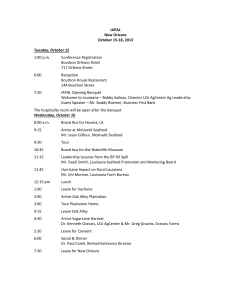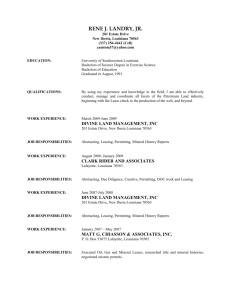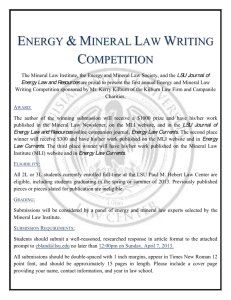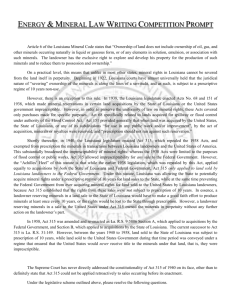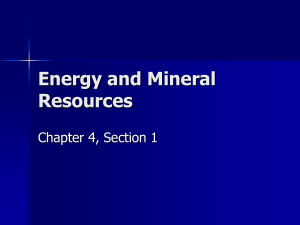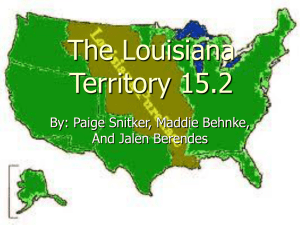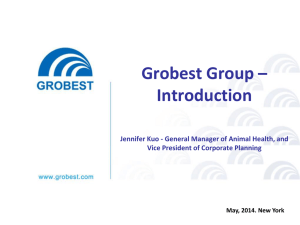Unit 2 – Section 3 –Louisiana`s Resources powerpoint
advertisement
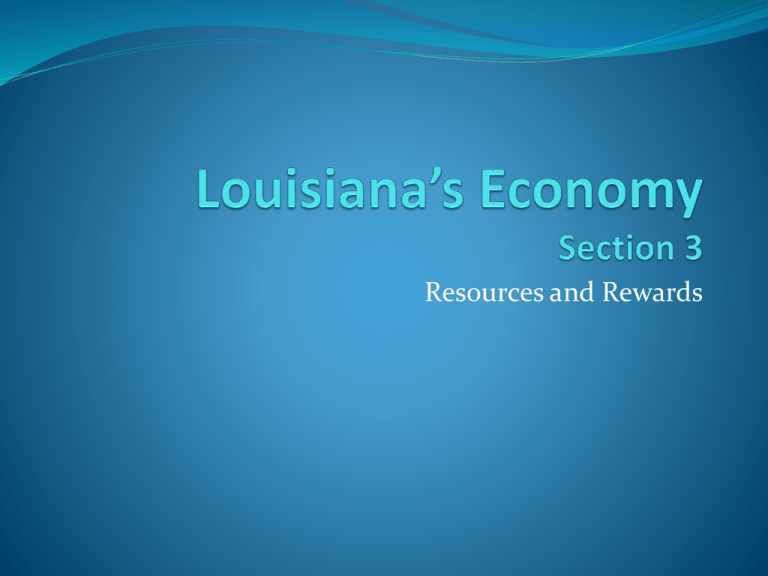
Resources and Rewards RESOURCE is a source of supply or support There are 5 types of RESOURCES: Natural Capital Human Renewable Non Renewable What are three types of resources found in the photograph below? NATURAL RESOURCES Is a gift of nature, or part of the natural environment Examples include: air, water, soil Can be MINERAL or BIOLOGICAL Non Renewable Resources Mineral Resources that are not replaced by nature once they are extracted from the environment. Inorganic substances that were formed by the Earth’s geologic processes. Examples include: oil, natural gas, & salt. MINERAL RESOURCES OIL Made from plant decay 10 million years ago. Louisiana has 10% of the world’s known oil reserves in the U.S. Louisiana is the 3rd largest oil producer in the U.S. Chemicals refined from oil create an almost unlimited list of other products. MINERAL RESOURCES Natural Gas Louisiana has more natural gas than oil deposits. Louisiana produces 25% of U.S. supply. Is converted to carbon black, which is used in making tires, carbon paper, & ink, etc… Burns clean & is very efficient. Fuel for homes & industries. MINERALS RESOURCES Salt Essential to the diet of both humans & animals. Used as a form of money. Not just used for preserving food. Makes a chemical that is used to make PVC pipes, plumbing & outdoor furniture. During the Civil War an underground salt deposit was discovered on Avery Island. MINERAL RESOURCES Sulphur A mineral used today to make matches, gunpowder, medicine, & plastic. The town of Sulphur developed the industry. Production peaked in 1904, but was played out by 1924. Port Sulphur, in Plaquemines Parish was also named because of the its Sulphur industry. MINERAL RESOURCES Lignite Brownish-black coal – found in DeSoto Parish. Lowest quality of coal because of high water content. Gained importance in the 1970’s. U.S. government encouraged the use of other sources of energy after a shortage of imported oil occurred. RENEWABLE RESOURCES Biological resources that replenish themselves over time Examples include: plants & animals BIOLOGICAL RESOURCES Are plants & animals, & replenish themselves in time. Biological Resources are Renewable Resources. Example: Spanish Moss was sold as stuffing for mattresses & furniture but now is used for bedding in minnow farms BIOLOGICAL RESOURCES Forests Trees are LA’s 2nd largest income producer Louisiana has more than 13.9 million acres of forests. 90% of trees cut down are pine, 75% is used to make pulpwood for making paper A new forestry industry is a Christmas Tree Farm, more than 150 in Louisiana supply this seasonal specialty. BIOLOGICAL RESOURCES Wildlife Why are we known as the Sportsman’s Paradise? The demand for fur is down so trapping has decreased The alligator is important to the ecosystem as well as the economy, because it is endangered we now have alligator farms BIOLOGICAL RESOURCES Fish and Seafood Fishing is an industry, mostly done for recreation due to the abundance of rivers, lakes, & bayous. The Gulf of Mexico supplies us with generous harvests of seafood. The Louisiana commercial fishing industry catches about 25% of the U.S. seafood. Catfish & crawfish are now are farmed. Atchafalayla Basin produces millions of pounds of crawfish annually. BIOLOGICAL RESOURCES Fish and Seafood What are some other seafood products important to Louisiana? How do you think the oil spill affected the fishing and seafood industry? CAPITAL RESOURCES Include buildings & equipment used to produce goods & services Examples include: schools, hospitals, or the refineries HUMAN RESOURCES People who supply the labor to produce goods & services Examples include: you & me LABOR UNIONS Groups of workers organized to demand fair pay and safe workings conditions.

